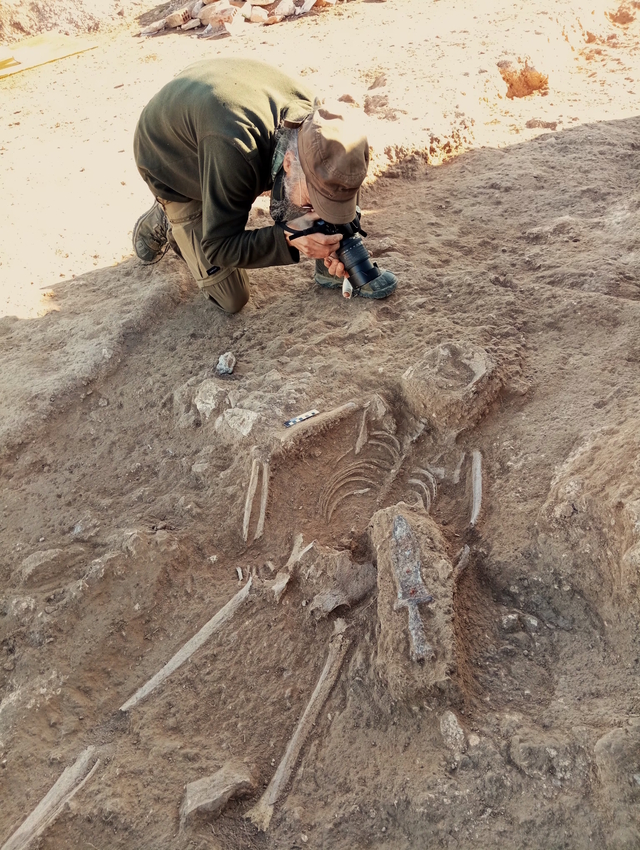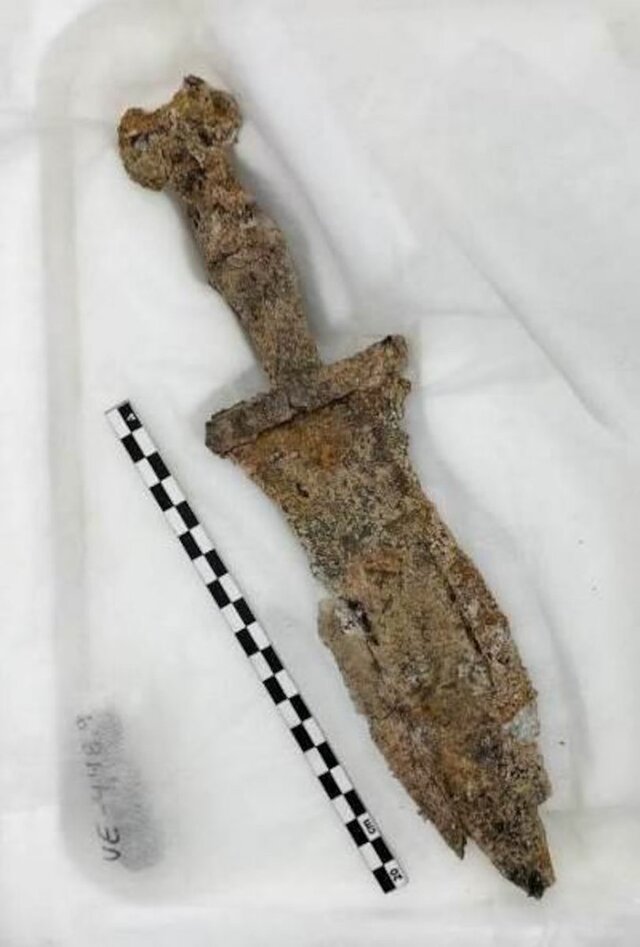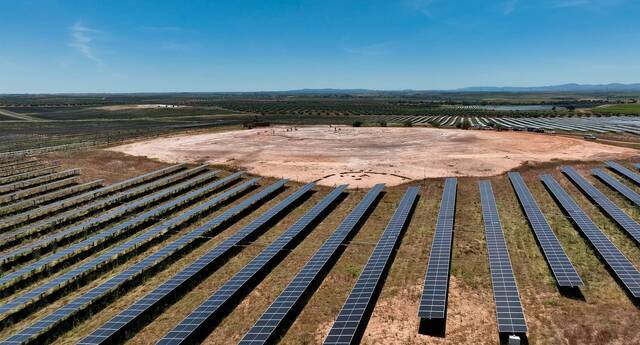In the rugged hills of Almendralejo, Spain, a remarkable discovery has emerged that sheds light on the complex and often violent history of ancient civilizations. A massive fortress built during the Copper Age, roughly 4,900 years ago, has been unearthed, revealing the level of sophistication and defense strategies of its creators. Just as intriguing is a mysterious Roman burial found nearby, which appears to tell a tale of a soldier’s final, dishonorable resting place. This discovery, spanning from the Chalcolithic to the Roman period, provides new insights into the life, death, and destruction of ancient peoples, revealing both their ingenuity and the violence that often accompanied their existence.
The Discovery of the Copper Age Fortress
The fortress was uncovered during the construction of a photovoltaic park on the Marquis de la Encomienda estate near Almendralejo, in the Extremadura region of Spain. The stronghold dates back to the Copper Age, around 2,450 BC, and was constructed with strategic foresight on a hilltop 1,030 feet above sea level.

This elevated position offered its inhabitants a commanding 360-degree view of the surrounding landscape—an ideal location for a fortified settlement. Initially, the fortress was constructed with a thick pentagonal adobe wall, reinforced by five bastions and a narrow, crab-claw-shaped entrance, designed to restrict access and defend against invaders.
Video
Watch this video to learn how this photovoltaic complex contributes to one of Spain’s greatest archaeological discoveries, highlighting the intersection of modern technology and ancient history.
Fortress Defense and Structure
As archaeological excavations continued, it became evident that the fortress was far more advanced than initially thought. Over time, two additional concentric walls were added, reinforced by three deep defensive ditches, which ranged up to four meters wide and two meters deep. These defensive features served not only as physical barriers but also as psychological deterrents, complicating any potential siege. The 25 bastions, strategically placed around the fortress, gave defenders numerous firing angles to hold off attackers. This meticulous attention to defense design suggests a well-organized and prepared society capable of mounting a strong resistance in times of threat.

The layout of the fortress itself reveals much about the priorities and capabilities of its creators. The site spans more than three acres, with remains of huts, a water reservoir, and various everyday objects found within the walls, indicating a well-coordinated effort to support its inhabitants. These findings suggest the presence of leadership and an organized labor force capable of building and maintaining such a complex defense structure.
Evidence of Violence and Destruction
Despite its formidable defenses, the fortress ultimately fell to its enemies. Evidence of destruction, including the remains of a fire that consumed key parts of the settlement, offers clues about the violent end of the Copper Age stronghold. Archaeologists found that even the wooden doors, which were embedded in the adobe walls, had been consumed by flames—remarkable, given that adobe is typically non-flammable.
The strategic placement of arrowheads in the burn layers reinforces the idea that the fire was likely a result of a deliberate attack rather than an accidental blaze. The presence of these arrowheads, along with other objects such as axes and grinding stones, paints a picture of a brutal assault, ultimately leading to the abandonment of the site by 2,450 BC.

Life Within the Fortress
Inside the fortress, archaeologists discovered a wealth of artifacts that offer glimpses into the daily life of its inhabitants. Items such as plates, bowls, loom weights, and axes indicate that the people of this fortification had a structured society with specific roles and responsibilities. The presence of a water reservoir suggests that the fortress was built with long-term survival in mind, capable of sustaining its population during times of siege or attack. Additionally, the discovery of huts within the fortress walls shows that the stronghold was not just a place of defense but also a place of residence, further highlighting the organized and communal nature of the people who lived there.
The Abandonment and Gap in Occupation
After being abandoned around 2,450 BC, the site remained empty for over 2,700 years. It wasn’t until the Roman Imperial period (2nd–3rd centuries AD) that the area saw human activity once again. The return of human presence is marked by an unusual discovery—an isolated burial near the fortress’ second defensive ditch. This grave, seemingly out of place in a site that had been dormant for millennia, holds the key to a fascinating mystery.
The Mysterious Roman Burial
The burial uncovered in 2021 was a solitary and somewhat hasty one. The remains of a man, aged between 25 and 35, were found face down with a pugio (a Roman dagger) placed across his back. This burial practice, particularly the placement of the dagger, suggests that the individual may have been a Roman soldier, though the circumstances surrounding his death remain shrouded in mystery. The unusual position of the body and the severed feet point to the possibility of a dishonorable burial—a rare and intriguing practice for the period.

The pugio, which was an essential weapon for Roman legionaries, provides further evidence to support the theory that this individual was a soldier. The exceptional state of preservation of the dagger, still intact in its sheath, is remarkable. Initially, there was debate among archaeologists about whether the remains belonged to a soldier or a civilian who had simply acquired the dagger. However, the deliberate placement of the pugio in the burial strongly suggests that the individual had a military role, and the dishonorable nature of the burial adds a layer of intrigue to the story.
The Role of the Pugio in Roman Military Culture
The pugio was a standard-issue dagger used by Roman soldiers, and its presence in the burial has led to speculation about the individual’s military status. The pugio, derived from earlier Iberian daggers used by the Celtiberians and other tribes, became a symbol of Roman military strength. As Roman soldiers fought against these tribes, the pugio was adopted as part of the legionary’s gear. The presence of the dagger, placed so conspicuously in the burial, suggests that this individual may have been a member of the Legio VII Gemina, the only Roman legion stationed in Hispania at the time. This legion, primarily tasked with escort duties, road surveillance, and provincial security, may have had soldiers stationed at this very site.

Ongoing Research and Mysteries
While the archaeological team continues to study the remains and the dagger, they are also attempting to extract DNA from one of the deceased’s teeth in hopes of uncovering more details about his life and origins. The cause of death, the unusual face-down burial, and the severed feet remain a mystery, leaving archaeologists eager to piece together this fascinating and rare story. Whether this individual was a soldier who had fallen out of favor or a victim of a particular fate remains unknown, but it’s clear that the discovery has opened a door to a chapter of Roman military history that is rarely uncovered.
Video
Check out this video to uncover the shocking discovery of a Roman soldier buried face down, with something unexpected found on his back, shedding light on ancient burial practices.
Conclusion
The discovery of the Copper Age fortress and the Roman burial near Almendralejo offers a rare and fascinating glimpse into the past. It tells the story of ancient civilizations—from the defensive strategies of Copper Age societies to the mysterious, potentially dishonorable end of a Roman soldier. As researchers continue to investigate the site and analyze the remains, more secrets of this ancient stronghold and its later occupation are sure to unfold, shedding light on the lives and deaths of those who once walked the Iberian Peninsula. This archaeological find not only enriches our understanding of ancient history but also sparks curiosity about the stories that still lie buried beneath the earth.



